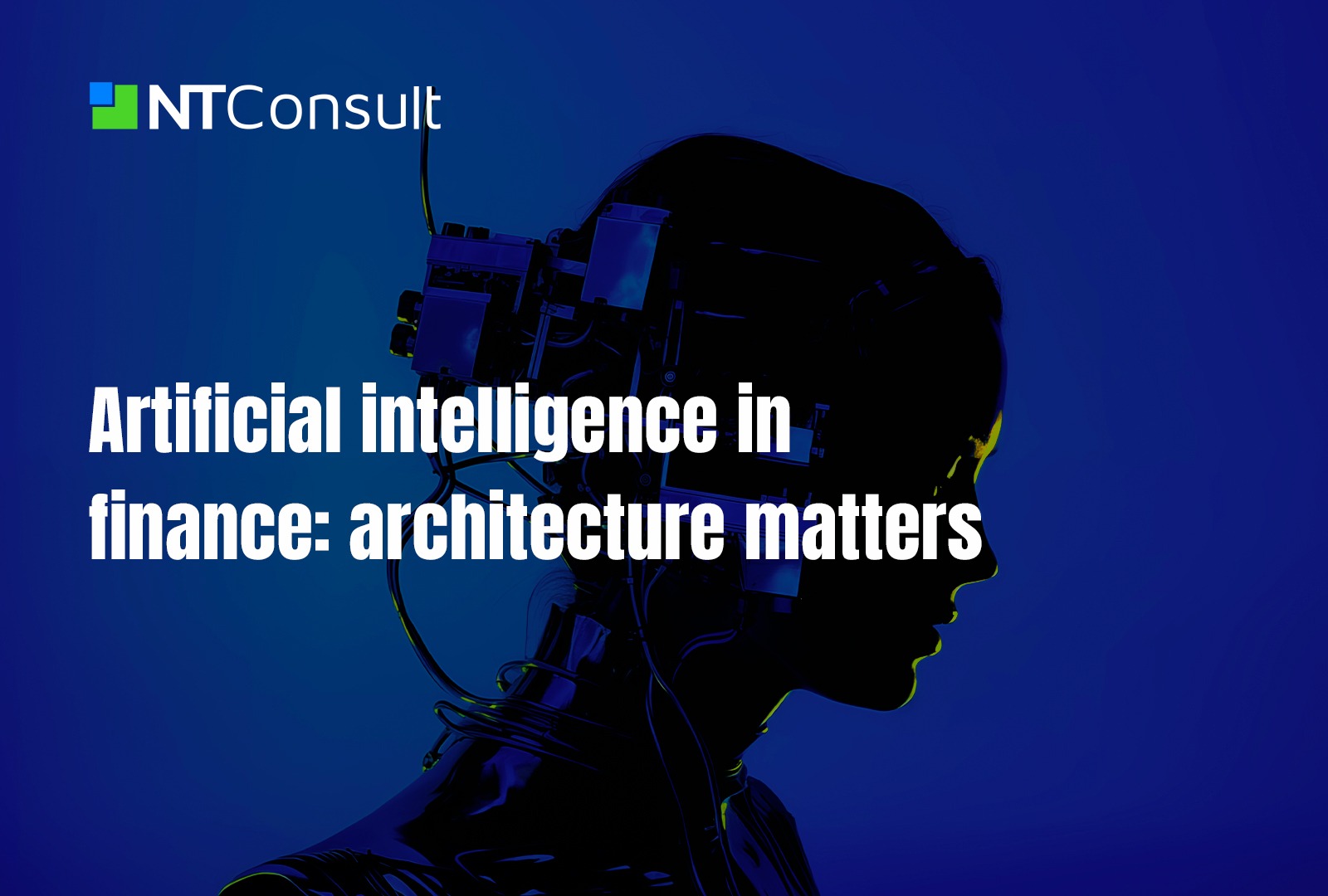Artificial intelligence is reshaping finance in measurable ways. From fraud detection to credit scoring, AI is now embedded in how institutions assess risk, optimize operations, and serve clients. But the success of these initiatives doesn’t come from the model alone, it depends on sound architecture, clear governance, and integration with the systems already in place.
For financial leaders under pressure to modernize, these demands raise a challenge: how to scale AI while maintaining compliance, transparency, and long-term value. Many projects stall because the foundation, from data pipelines to regulatory safeguards, isn’t ready.
NTConsult works with financial organizations that need AI to perform reliably, at scale, and under scrutiny. We design solutions that meet technical and business expectations, supporting everything from AI implementation in banking to explainable models, system integration, and platform governance.
This article outlines where AI is showing value in finance, what makes deployment succeed, and how to approach architecture, regulation, and integration with maturity. It reflects the lessons we’ve learned delivering results in some of the most demanding financial environments.
Where AI in finance is delivering real value
Artificial intelligence is already influencing how financial institutions operate in real production environments. Some of the clearest gains come from focused, assistive AI systems that enhance human decision-making without replacing it.
Fraud detection is a leading example. AI models trained on historical transaction patterns are now used to flag anomalies in real time, helping banks respond to threats faster. Credit scoring has also evolved, with machine learning models offering more nuanced risk assessments by analyzing non-traditional data points. Predictive analytics, too, is improving how institutions forecast market trends, optimize capital allocation, and manage portfolios.
In customer-facing roles, AI-powered chatbots and virtual assistants are improving response times and reducing operational load, particularly in retail banking. These tools rely on robust AI architecture in finance to function reliably, integrating with internal CRMs, call logs, and knowledge bases to deliver accurate, context-aware responses.
What these applications share is a reliance on structured data, well-defined objectives, and supervised model behavior. Most deployments in finance remain assistive, supporting human decision-making rather than replacing them. This reflects a broader trend toward incremental AI adoption, grounded in specific business problems, not broad automation agendas.
As these systems become more embedded, their performance and reliability depend less on the algorithms themselves and more on the environments in which they operate, from data architecture to governance and integration. These dependencies are the next hurdle for institutions moving beyond pilot projects.
AI’s strategic horizon: evolving applications, enduring principles
While current use cases like fraud detection, credit scoring, and virtual assistants demonstrate clear value, they represent just the beginning. The pace of AI innovation in finance continues to accelerate, with new, strategic applications emerging at the intersection of process orchestration, data interoperability, and real-time decisioning.
In this context, what separates successful institutions is not the technology itself, but their ability to apply AI with purpose: aligning its use with business goals, governance frameworks, and measurable ROI. It’s not about adopting AI for AI’s sake, it’s about designing intelligent systems that elevate performance, scale with confidence, and deliver long-term value.
This is precisely where NTConsult delivers strategic advantage. By combining deep expertise in AI, architecture, and regulated environments, we help financial organizations turn emerging AI possibilities into reliable, production-grade outcomes.
The hidden dependencies: AI needs architecture
Many AI projects begin with strong potential but stall when asked to scale or face regulatory scrutiny. The gap isn’t usually in the model, it’s in the architecture supporting it. Data flows, system integration, and monitoring infrastructure define whether an AI system becomes operational or remains a promising proof of concept.
Architectural planning is the foundation. AI models depend on clean, reliable data pipelines and secure access to production environments. Model serving infrastructure must be able to scale and adapt as usage patterns change. Real-time monitoring is essential for identifying drift, ensuring compliance, and maintaining performance under load.
Siloed POCs often fail because they bypass these realities. When AI is developed without integration into existing systems (whether CRMs, data warehouses, or compliance tools) its value remains theoretical. Connecting outputs to actual business processes, and ensuring that those processes remain traceable and controllable, is where architectural discipline becomes essential.
This is especially relevant in environments where legacy systems remain in place. Rather than replacing core platforms, many financial institutions need AI solutions that can interoperate with what’s already running. That requires platform-agnostic design and frameworks that allow modular, non-invasive deployment.
Organizations that invest in architecture from the outset are more likely to see measurable impact from AI. The value lies less in model complexity and more in the environment that enables reliable, secure, and scalable execution.
AI in regulated environments: governance, explainability, and risk
Adopting artificial intelligence in financial services involves navigating a complex regulatory landscape. Compliance, transparency, and auditability shape how AI systems are built, deployed, and maintained from the outset.
To operate within these constraints, AI models must be explainable, traceable, and accountable. That means every model in production should come with clear documentation, risk classification, and defined use cases. Drift monitoring is essential to track how model behavior changes over time. Human-in-the-loop mechanisms remain standard in use cases that affect credit decisions, fraud alerts, or regulatory thresholds.
This is the foundation of AI governance in financial services. It includes technical safeguards like access control, versioning, audit logs, and data lineage, as well as operational practices that ensure consistent oversight. Governance in AI requires continuous oversight aligned with internal policies and regulatory expectations.
Global frameworks are pushing these expectations forward. The EU AI Act (Artificial Intelligence Act of the European Union) introduces risk-based classifications and compliance requirements for high-impact systems. In the U.S., the AI Bill of Rights outlines principles of transparency, fairness, and accountability that are influencing financial regulators and institutions alike. Navigating these frameworks demands systems that are verifiable by design.
Institutions that can’t explain how their models work, or prove that decisions are auditable and reversible, will face increasing scrutiny. For AI to deliver real value in finance, it must operate with the same rigor expected of any core system: resilient, documented, and ready for inspection.
Integrating AI with legacy systems: the real challenge
Bringing AI into production environments rarely starts from a clean slate. In finance, many core operations still run on legacy infrastructure, from COBOL-based mainframes and on-premise CRMs to fragmented data lakes built over decades. These systems hold essential business logic and data, yet were never designed to interact with modern AI workflows.
Integrating AI in this context introduces significant friction. Data pipelines may be incomplete or inconsistent. System interfaces are often proprietary or undocumented. Real-time processing becomes difficult when batch jobs define the system’s cadence. These are not exceptions, they are the default conditions in many financial organizations.
To overcome this, integration strategies must prioritize interoperability. API-first architectures, middleware layers, and process orchestration platforms create a bridge between AI models and existing systems. Instead of rewriting core applications, organizations can introduce modular components that interact with legacy systems through well-defined interfaces, reducing risk and preserving business continuity.
Agentic AI solutions further support this approach by enabling intelligence to operate alongside legacy environments, rather than within them. This “wrap-around” model allows for targeted automation and decision support without disrupting foundational systems.
In financial and telecom ecosystems, where system stability and data traceability are non-negotiable, successful AI integration depends more on architectural discipline than algorithmic innovation. Experience in navigating these environments, with a focus on orchestration and long-term maintainability, makes a measurable difference in delivery outcomes.
Agentic AI: autonomy with boundaries
In regulated sectors like finance, unrestricted AI autonomy raises concerns that go beyond technical feasibility, it can conflict directly with compliance standards. Institutions need systems that operate with purpose, within boundaries, and under consistent oversight.
Agentic AI addresses this need by enabling models to handle complex tasks independently, while remaining explainable, traceable, and governable. These systems are embedded into workflows, respond to escalation paths when required, and maintain detailed logs to support audit and compliance reviews.
In financial operations, this structured autonomy allows AI to accelerate decisions such as credit adjustments, anomaly detection, or document analysis, all while staying within frameworks that regulators and risk officers can inspect and understand.
The effectiveness of Agentic AI stems from its operational safeguards: role-based permissions, behavioral monitoring, defined fallback protocols, and architectural choices that reinforce accountability across the system lifecycle.
With this approach, institutions gain the ability to scale AI in a controlled manner, maintaining oversight without limiting performance.
Why nearshore alone isn’t enough: expertise is everything
Nearshore delivery can solve part of the equation, it often improves collaboration through time zone alignment, cultural proximity, and more efficient communication cycles. But proximity does not guarantee performance. In regulated, high-stakes environments like finance and insurance, success hinges on something else entirely: the depth of expertise behind the solution.
AI initiatives in these sectors demand fluency in architecture, regulatory expectations, and integration realities. Teams must navigate legacy systems, ensure traceability, and build scalable frameworks that support explainability and risk control from day one. Domain knowledge shapes every design decision, from data modeling to deployment governance.
What often differentiates sustainable projects from failed pilots is delivery maturity. That means more than completing tickets or coding fast. It’s about anticipating failure modes, structuring work for long-term maintainability, and engaging stakeholders with clarity and accountability throughout the process.
This is why technical leaders don’t look for vendors who simply fill roles, they rely on partners who understand the stakes, challenge assumptions, and are prepared to own the result.
In this landscape, NTConsult stands out not because of delivery location, but because of its track record: solving complex problems in financial systems with predictability, architectural rigor, and long-term accountability.
Two decades of trust: NTConsult’s financial sector legacy
In an industry where transformation is often driven by urgency, there’s lasting value in experience. For over 20 years, NTConsult has worked alongside financial institutions across the Americas, supporting system modernization efforts in some of the most regulated and technically complex environments.
This depth of engagement, from integration across legacy platforms to compliance-driven architecture, has shaped the way NTConsult approaches AI. Projects aren’t treated as isolated initiatives, but as part of a larger strategy where explainability, operational visibility, and audit readiness are built in from the start. That consistency is why institutions operating under intense regulatory scrutiny continue to rely on NTConsult not as a vendor, but as a strategic advisor.
This kind of track record is what gives AI initiatives staying power in finance. Architecture, governance, and legacy integration form the operational backbone that supports real, measurable outcomes.
For organizations navigating these challenges, selecting a partner who understands both the technology and the institutional context makes the difference between a model that runs in a lab and a solution that survives in production.
Looking to scale AI with predictability, compliance, and long-term impact?


 Portuguese
Portuguese Spanish
Spanish


